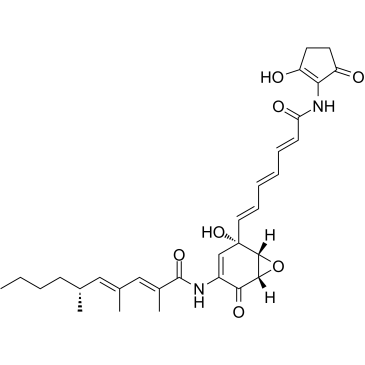Transcriptional regulation and increased production of asukamycin in engineered Streptomyces nodosus subsp. asukaensis strains.
Pengfei Xie, Yan Sheng, Takuya Ito, Taifo Mahmud
文献索引:Appl. Microbiol. Biotechnol. 96(2) , 451-60, (2012)
全文:HTML全文
摘要
Asukamycin, a member of the manumycin family of antibiotics, exhibits strong antibacterial, antifungal, and antineoplastic activities. However, its production in the wild-type strain of Streptomyces nodosus subsp. asukaensis ATCC 29757 is relatively low. Recently, the biosynthetic gene cluster for asukamycin was identified in the producing organism, and among the 36 genes reported in the cluster, six (asuR1-asuR6) were proposed to encode proteins that function as transcriptional regulators. In order to investigate their involvement in asukamycin biosynthesis and to engineer mutant strains of S. nodosus that are able to produce large amounts of asukamycin, we carried out in vivo gene inactivation, transcriptional analysis of the biosynthetic genes in the mutants, and gene duplication in the producing strain of S. nodosus. The results show that two of the putative regulatory genes (asuR1 and asuR5) are critical for asukamycin biosynthesis, whereas others regulate the pathway at various levels. Overexpression of a gene cassette harboring asuR1, asuR2, asuR3, and asuR4 in S. nodosus resulted in changes in morphology of the producing strain and an approximately 14-fold increase of asukamycin production. However, overexpression of the individual genes did not give a comparable cumulative level of asukamycin production, suggesting that some, if not all, of the gene products act synergistically to regulate the biosynthesis of this antibiotic.
相关化合物
| 结构式 | 名称/CAS号 | 分子式 | 全部文献 |
|---|---|---|---|
 |
手霉素A
CAS:52665-74-4 |
C31H38N2O7 |
|
Statins inhibit protein lipidation and induce the unfolded p...
2009-10-27 [Proc. Natl. Acad. Sci. U. S. A. 106(43) , 18285-90, (2009)] |
|
[Effects of manumycin combined with methoxyamine on apoptosi...
[Chin. J. Cancer 27(8) , 835-9, (2008)] |
|
Polygonatum cyrtonema lectin induces murine fibrosarcoma L92...
2010-12-01 [Biochimie 92(12) , 1934-8, (2010)] |
|
Plumbagin activates ERK1/2 and Akt via superoxide, Src and P...
2010-07-25 [Eur. J. Pharmacol. 638(1-3) , 21-8, (2010)] |
|
Farnesyltransferase inhibitors reduce Ras activation and ame...
2009-11-01 [Hepatology 50(5) , 1547-57, (2009)] |